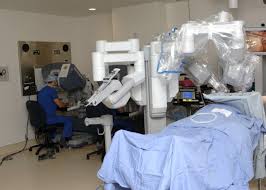Transoral Robotic Surgery (TORS)
Due to the narrow confines of the mouth and throat, it can be very difficult to perform surgery in these areas. TransOral Robotic Surgery (TORS) is a minimally invasive surgical procedure that allows a small, angled camera to be placed on one arm of a robot, while the other two arms allow for 720 degrees of motion in the depths of the mouth and throat.
TORS utilizes the Da Vinci Robotics System™, which has been used throughout the world for over 10 years in other surgical specialities. The robotic system has specially developed arms, which are smaller and more articulate in their movements, for use in the narrow confines of the mouth and throat.

What are the uses of TORS?
TORS is a minimally invasive surgical procedure used for removing benign and cancerous lesions of the tonsils, tongue base and larynx, and is also used for obstructive sleep apnea (OSA) surgery.
How do I know if my sleep apnea can be helped by TORS?
Prior to undergoing sleep surgery, all patients of Dr. Athavale are taken to the operating room for a procedure known as “sleep endoscopy.” During this procedure, Dr. Athavale watches what portions of your nose and throat collapse while in the sleep stage. This allows for more targeted, precise and personalized surgery for OSA.
What types of cancers are amenable to TORS?
TransOral Robotic Surgery is a minimally invasive surgical procedure for removing cancers of the tonsils, tongue base and larynx, and utilizes the Da Vinci robot. However, not all patients with cancers of the tonsil, tongue base or larynx cancer are candidates for this procedure. TORS is only offered if it has the potential of reducing side effects of treatment compared to other available treatment options.
Generally speaking, the decision to use TORS for cancer resection is made at a multi-disciplinary cancer meeting with medical oncologists, radiation oncologists, radiologists and pathologists present to discuss your case. If the team feels that using TORS to remove your tumor would decrease the amount of radiation and chemotherapy you might receive, they will proceed.
How does robotic surgery work?
The Da Vinci robotic system uses three arms. A central arm has a binocular high resolution camera, and the two side arms serve as the working “hands” of the robot.
These hands are much smaller than human hands and allow for skilled movements in the narrow confines of the throat – something that has previously never been possible. The surgeon is seated at a console where he directs the movement of these hands and in this way, performs the operation.

Dr. Athavale is still performing the operation, but uses these robotic hands rather than his human hands.
What are the benefits for people undergoing transoral robotic surgery?
Transoral robotic surgery of the head and neck allows for the removal of tumors in a more efficient fashion than in traditional open operations. As a result, recovery and ultimate patient function and appearance can be much improved. This does not require any open neck incision or flap closure.
Will I have visible scars from TRS?
Transoral robotic surgery produces no external scars but is often combined with removal of lymph nodes from the neck, which can leave a single scar on the neck. Every effort is made to make this scar as inconspicuous as possible.
Are there side effects or complications due to robotic surgery?
The primary side effects of surgery include an initial period of discomfort much like a tonsillectomy, and also a small risk of bleeding after surgery. Problems with speech and swallowing after transoral robotic surgery are usually minor.
Only three in 100 patients will experience postoperative bleeding, with only one out of 100 patients requiring intervention to stop bleeding. After robotic surgery for sleep apnea, patient will have some postoperative swallowing discomfort that also subsides after time.

How long is recovery after TORS?
Recovery following transoral robotic surgery is significantly shorter compared to open procedures, with patients experiencing fewer side effects and returning to normal activities sooner. Patients should contact Dr. Athavale’s office with further questions about what to expect.








 Make an Appointment
Make an Appointment